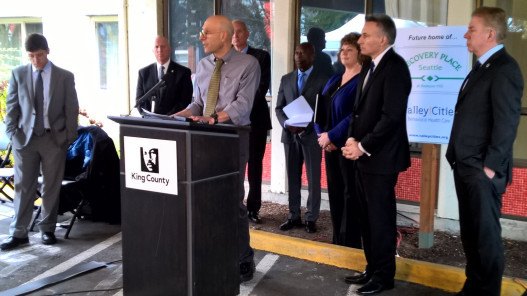The following is written by Jeff Duchin, MD, Health Officer for Public Health Insider:
In King County, we are in the midst of unprecedented epidemic of drug addiction and overdose caused by prescription pain medications and heroin. There were 156 heroin-related deaths in King County in 2014, the highest number in 20 years. As of Oct. 1, 2015, about 3,615 people were receiving methadone treatment in King County, but lack of treatment capacity leaves more than 150 people on a wait-list each day. Other effective treatment options exist, but they are used inconsistently and are not available in all parts of the county. In addition, substance abuse is one of the root causes of homelessness, and drug overdose is currently the leading cause of death among people who are homeless.
Injection opioid drug addiction is associated with high rates of morbidity and mortality, including structural and functional changes in the brain, life threatening bacterial infections of the bloodstream, heart, lungs, skin and other organs; HIV, hepatitis c and hepatitis B infections, injuries, and in pregnant women, complications of pregnancy and labor, and babies that are born dependent on opiate drugs and suffering from withdrawal.
The vast majority of people who use prescription opiate pain drugs don’t become addicted or ever use heroin. But because these drugs are so widely prescribed, even a small percentage translates to a large number of people who do be come addicted. And many, although not all, people who are addicted to heroin previously used prescription opiate drugs.
This epidemic constitutes a serous and increasing public health problem. Addiction to prescription pain medication and/or heroin is a chronic disease, like cardiovascular disease or diabetes, that is difficult to cure but can be effectively treated. We need to fight this epidemic as we would any other disease outbreak, with a multi-faceted public health approach to help people who are already addicted get treatment and prevent people from becoming addicted in the first place.
Punishment and stigmatization are not a cure for any disease.
What is the public health approach? Help people who are already addicted and prevent people from becoming addicted in the first place. Here a few examples:
We can help people who are already addicted through increasing access to medication-assisted treatment for as long as they need it and integrating addiction treatment into healthcare settings; through overdose prevention by expanded access to naloxone; by addressing co-existing medical and social needs to make treatment success more likely, and through harm reduction methods like syringe exchange to improve health outcomes and prevent deaths by preventing injection-related infections, overdose, and providing an access point for addiction treatment and for medical and social services.
We need to do a better job of early identification of people who are misusing or addicted to opiates in order to prevent addiction and transition to injection use. We also need better systems to track trends in opiate use and associated impacts.
We can prevent people from becoming addicted in the first place by targeting the excess availability of prescription pain medications through policy and clinical practice interventions such as the enhanced use of prescription-drug monitoring programs and development of clinical guidelines to educate clinicians; by educating families to safeguard prescribed drugs from diversion and through family- and community-based drug-abuse prevention programs.
I’m looking forward to working with colleagues in King County’s Department of Community and Human Services and our team of community stakeholders and collaborators on the new King County and Seattle Task Force on Heroin and Prescription Opiate Addiction to develop a community-wide approach to turning this epidemic around as soon as possible.


